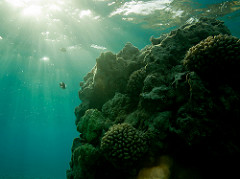Nikita Daryanani is a summer intern at NCSE. She recently graduated from UC Davis with a degree in Environmental Policy Analysis and Planning, and is interested in global climate change and environmental justice.
 If you’ve ever been snorkeling or diving (or watched Finding Nemo), you know that the ocean is a wonderful, colorful place that’s full of all kinds of creatures. But what you may not know is that even the ocean is vulnerable to the effects of climate change. This is because when we think of climate change and pollution, we think of giant smokestacks emitting thick, grey smoke into the clear blue sky, not into the ocean below.
If you’ve ever been snorkeling or diving (or watched Finding Nemo), you know that the ocean is a wonderful, colorful place that’s full of all kinds of creatures. But what you may not know is that even the ocean is vulnerable to the effects of climate change. This is because when we think of climate change and pollution, we think of giant smokestacks emitting thick, grey smoke into the clear blue sky, not into the ocean below.
But carbon dioxide in the atmosphere can affect the ocean, too. As it is absorbed by the ocean, the water becomes more acidic. As carbon dioxide emissions increase, the acidity of the ocean increases as well. This is called “ocean acidification.”
We’ve talked about the chemistry aspect of ocean acidification before on our blog, but if you’re looking for a resource that explains how this change in ocean chemistry is harming marine organisms, take a look at EarthVision Institute’s video on ocean acidification and coral reefs.
Marine ecologist Joanie Kleypas uses a very helpful analogy to explain the process of ocean acidification in a way that’s easy to understand. In this video, Kleypas compares it to the carbonization of water to make soda. When you put water in a closed bottle and add carbon dioxide to it, the water absorbs it and becomes bubbly, but also, more acidic. As it turns out, the same thing happens with the ocean, just without the bubbles. But unlike the water bottle, there are millions of species of plants and animals that live in the ocean and they need the ocean’s pH to stay pretty stable.
One of the most important of these are coral reefs. According to Kleypas, “a third of the world’s fish species use a coral reef at some time or another.” They use it for nurturing their young, hiding from predators, as a food source, and more. No wonder scientists are so worried about this. She also points out that many organisms found in coral reefs have medicinal properties that are used in modern medicine. So it’s not just fish that benefit from having coral reefs around—humans do, too!
EarthVision has various other videos on subjects such as the scientific process and the polar vortex, as well as time-lapse videos of melting glaciers, so it is definitely worth checking out the website. We realize that videos only get you so far in a classroom, so you might couple the ocean acidification video with some of their other materials or a classroom activity that could really bring the point home.
Ocean acidification has been called “climate change’s evil twin” for good reason. It is a problem that is just as relevant and just as worrisome as climate change. Teaching kids about this issue not only allows them to learn about some interesting chemistry and biology concepts, but helps them better understand the scope of the challenges we are facing in the future.
Are you teaching about ocean acidification in your classroom this coming year? What resources are you using? Share your thoughts in the Comments section below.
Image from usfwspacific from Flickr
